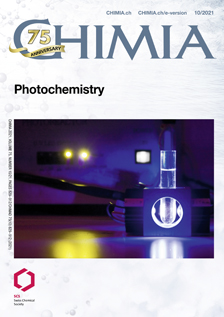Recent Approaches towards the Development of Ru(II) Polypyridyl Complexes for Anticancer Photodynamic Therapy
DOI:
https://doi.org/10.2533/chimia.2021.845PMID:
34728011Keywords:
Medicinal inorganic chemistry, Metals in medicine, Photodynamic therapy (PDT), Photosensitizer, Ru(II) polypyridyl complexAbstract
Photodynamic therapy (PDT) is a remarkable alternative or complementary technique to chemotherapy, radiotherapy or immunotherapy to treat certain forms of cancer. The synergistic effect of light, photosensitizer (PS) and oxygen allows for the treatment of tumours with an extremely high spatio-tumoral control, therefore minimizing the severe side effects usually observed in chemotherapy. The currently employed PDT PSs based on porphyrins have, in some cases, some limitations, which include a low absorbance in the therapeutic window, a low body clearance, photobleaching, among others. In this context, Ru(II) polypyridyl complexes are interesting alternatives. They have low lying excited energy states and the presence of a heavy metal increases the possibility of spin-orbit coupling. Moreover, their photophysical properties are relatively easy to tune and they have very low photobleaching rates. All of these make them attractive candidates for further development as therapeutically suitable PDT PS’s. In this review, after having presented this field of research, we discuss the developments made by our group in this field of research since 2017. We notably describe how we tuned the photophysical properties of our complexes from the visible region to the therapeutically suitable red region. This was accompanied by the preparation of PSs with enhanced phototoxicity and high phototoxicity index. We also discuss the use of two-photon excitation to eradicate tumours in nude mice. Furthermore, we describe our approach for the selective delivery of our complexes using targeting agents. Lastly, we report on our very recent synergistic approach to treat cancer using bimetallic Ru(II)-Pt(IV) prodrug candidates.
Downloads
Published
How to Cite
Issue
Section
License
Copyright (c) 2021 Gilles Gasser, Albert Gandosio, Kallol Purkait

This work is licensed under a Creative Commons Attribution 4.0 International License.







